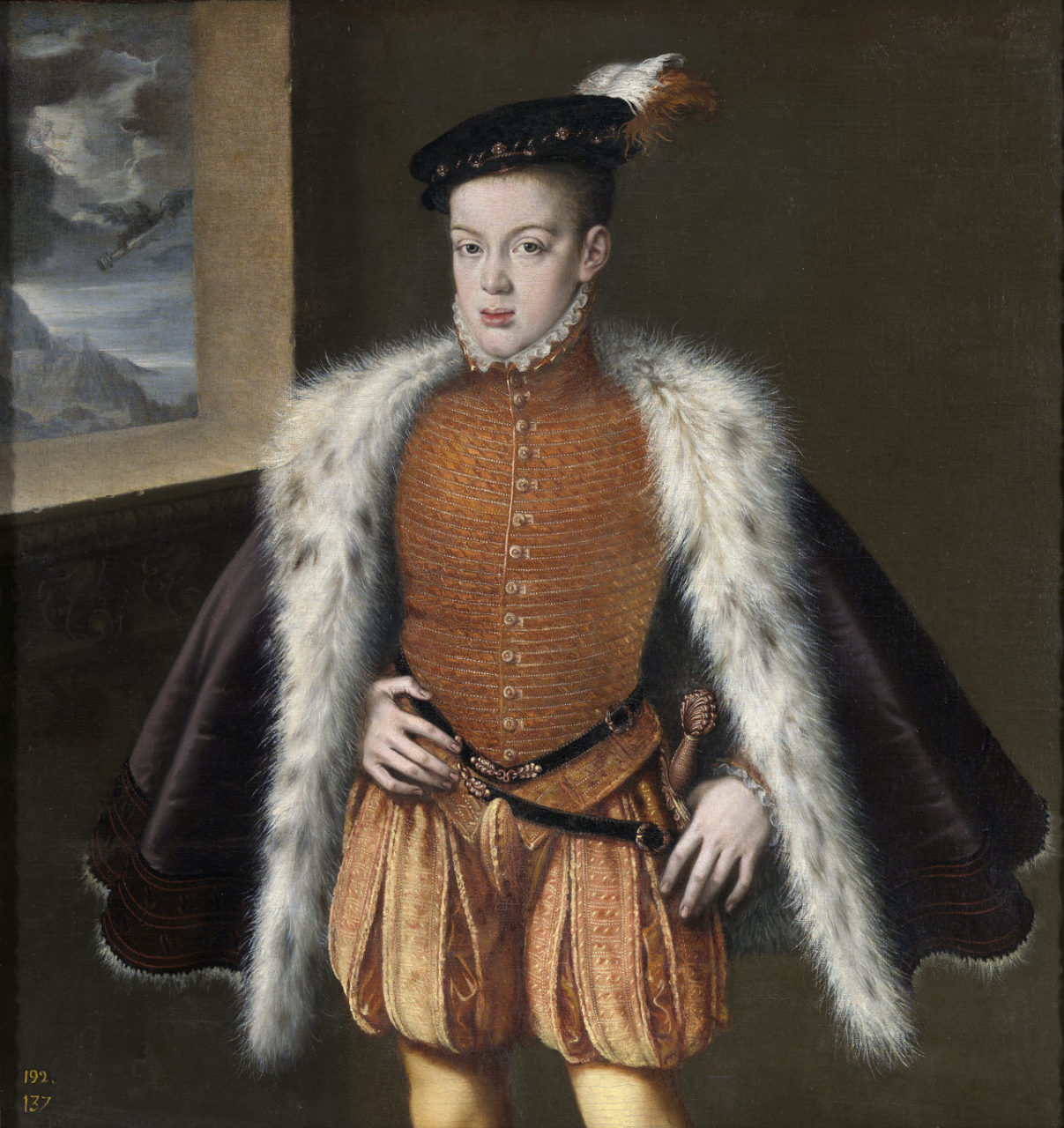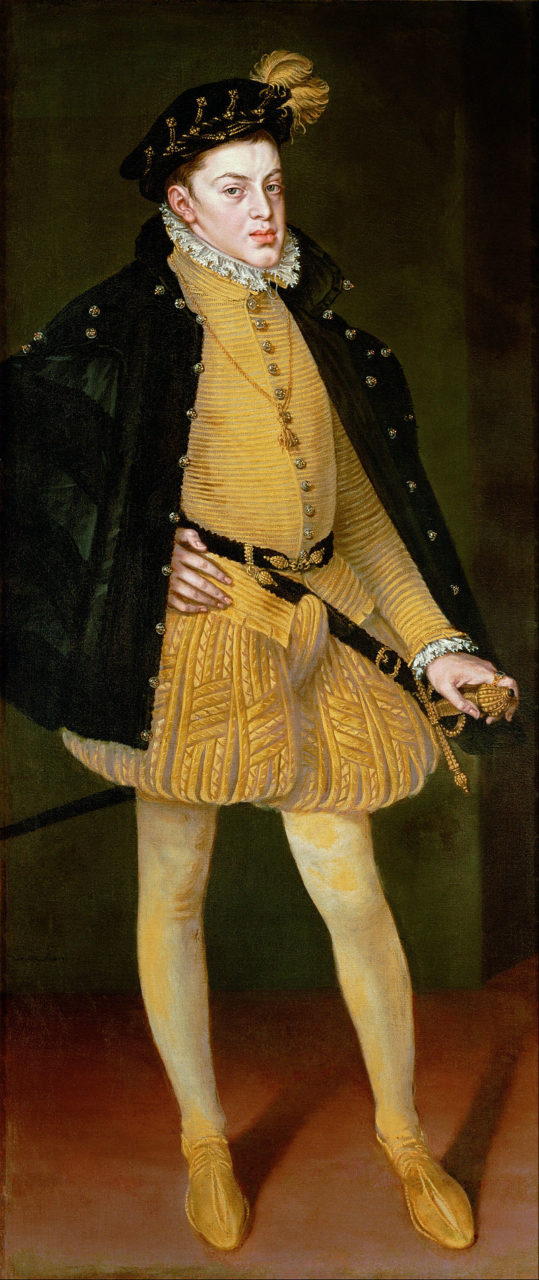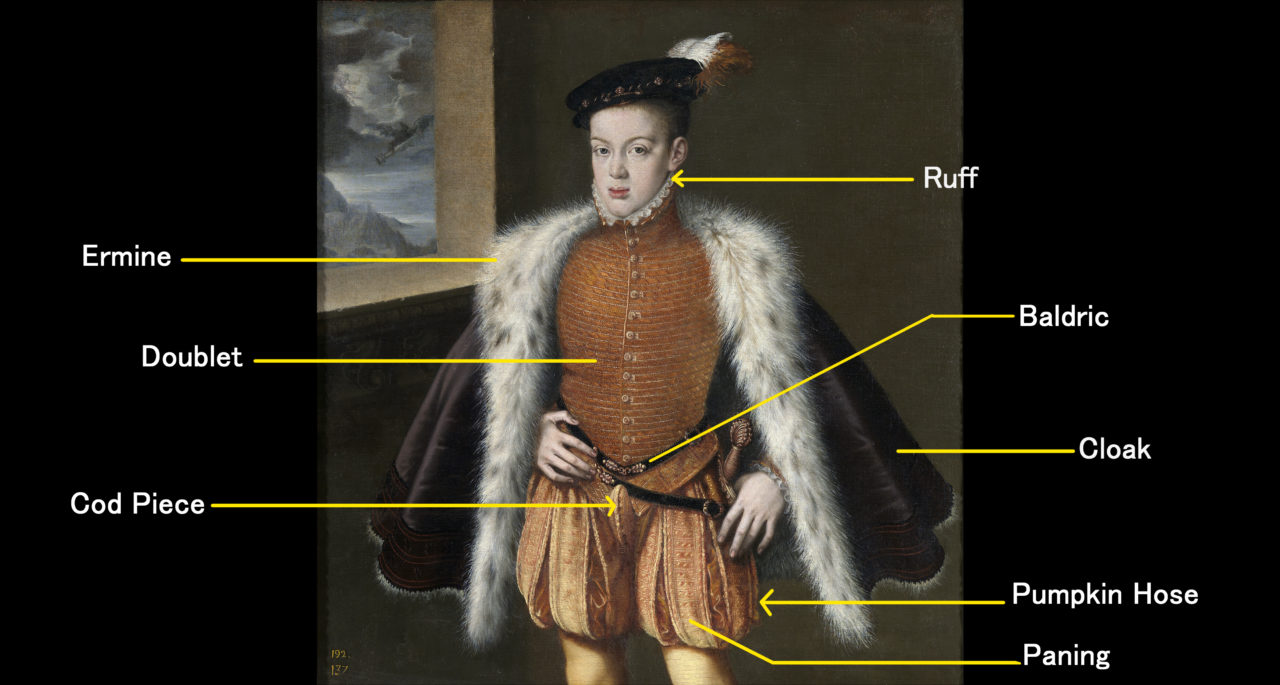The late 16th century’s fashion is characterized by its Spanish influence, and as a Spanish Prince, Don Carlos exhibits the height of the time’s fashion.
About the Portrait
Alonso Sánchez Coello (Fig. 1) was a Spanish Renaissance painter commended for his faithful portrayals of the subjects he was depicting, as art historian Alfonso Pérez Sánchez notes. He was a painter for the Spanish court during the reign of Philip II. He was highly favored in the court and gained great status and influence compared to other Spanish painters at the time (Pérez Sánchez). The painting depicts Prince Don Carlos, the eldest son of Philip II. He was 10-14 years-old at the time it was painted. In actuality, as the Prado notes, the Prince was born with physical deformities and mental disorders. Due to this, the portrait is very idealized and takes advantage of the time’s fashion to disguise his malformations (Museo del Prado).
Fig. 1 - Attributed to Alonso Sanchez Coello (Spanish, 1531-1588). Self-Portrait, ca. 1570. Oil on panel; 41 x 32.5 cm (16 x 13 in). Madrid: Museo del Prado, P02511. Source: Prado
Alonso Sánchez Coello (Spainish, 1531-1588). Prince Don Carlos of Austria, 1555-1559. Oil on canvas; 109 x 95 cm (42.9 x 37.4 in). Madrid: Museo del Prado, P01136. Source: Museo Nacional del Prado

About the Fashion
Prince Don Carlos of Austria is depicted in a buttoned jacket known as a doublet. Tabs can be seen at the bottom edge of the doublet. At the end of the high neck of the doublet, he wears a small ruff, possibly made of lace (Eubank & Tortora 215). Similar doublets and ruffs can be seen being worn in the portrait of François Clouet (Fig. 2) and the portrait of Don Carlos from a few years later (Fig. 3). As these were painted in the mid-16th century, the ruffs are fairly small, as the century progressed, ruffs would enlarge. His cuffs also have a ruffled edging. On top of the doublet, he wears a cloak, which is lined in lynx fur–very luxurious and characterized by its black specks of fur against the white. Wearing luxury fur was a clear way to show one’s wealth and status, as they were very difficult and expensive to get. A very similar Spanish cape lined in lynx appears in the portrait of the French Prince Hercule-François, Duc d’Alençon (Fig. 4). Around Don Carlos’ waist you can see a baldric carrying his sword seen to his left (similar baldrics/swords appear in figures 3-5).
Moving down, one can see he’s wearing pumpkin hose. The strips of fabric spanning them up and down is known as paning; the paning appears to have small slits, or ‘pinks’ in it. Below that, he’s wearing stockings, which, at the time, could have been knit or simply sewn (Eubank & Tortora 183). He is also wearing a prominent codpiece, i.e. “pouches of fabric for the genitals sewn (on) the front” (180). On his head, he wears what Jack Cassin-Scott refers to in the Illustrated Encyclopedia of Costume and Fashion as a court bonnet: “The Court bonnet was made in velvet or cloth and trimmed with jewelled ornaments and a small feather plume” (26). Don Carlos’ costume exhibits the ideal silhouette of his time. In the mid-16th century, the very wide rectangular look fades away and a triangular look becomes more desirable; the painting of Prince Hercule-François (Fig. 4) is a good full-body example of this. Another characteristic of mid-16th century men’s fashion is the peascod belly, in which padding is placed in front of the doublet; seen most clearly in the portrait of Robert Dudley (Fig. 5). This is something that becomes more pronounced as the century progresses, so Don Carlos doesn’t quite exhibit one as exaggerated yet.
Fig. 2 - François Clouet (French, 1510-1572). Portrait of a Man, called the Duc d'Alençon, 1569. Oil on panel; 35.9 x 26 cm (13.7 x 10.2 in). Edinburgh: National Galleries Scotland, NG 2426. Accepted by HM Government in lieu of inheritance tax and allocated to the National Gallery of Scotland, 1984. Source: National Galleries of Scotland
Fig. 3 - Alonso Sánchez Coello (Spanish, 1531-1588). Infant Don Carlos, 1564. Oil on canvas; 186 x 82.5 cm (73 x 32 in). Vienna: Kunsthistorisches Museum, Gemäldegalerie, 3235. Source: Kunsthistorisches
Fig. 4 - Artist unknown. Prince Hercule-François, Duc d'Alençon, 1572. Oil on canvas; 188.6 x 102.2 cm (74 x 40 in). Washington: National Gallery of Art; Samuel H. Kress Collection, 1961.9.55. Source: National Gallery of Art
Fig. 5 - Attributed to Steven van Herwijck (Netherlandish, 1543-1568). Portrait of Robert Dudley, 1st Earl of Leicester, 1560s. Oil on panel; 114 x 86 cm (45 x 34 in). Private Collection. Source: Historical Portraits
Men’s dress of the later half of the 16th century was characterized by its Spanish influence, and as a Spanish prince, it would make sense that he’s seen in all the most fashionable trends of the time (Hill 388). This certainly isn’t a costume that would be worn by anyone not of high-status.
References:
- Cassin-Scott, Jack. The Illustrated Encyclopaedia of Costume and Fashion: From 1066 to the Present. London: Cassell Illustrated, 2006. http://www.worldcat.org/oclc/65329784.
- “El Príncipe Don Carlos – Colección.” Museo Nacional del Prado. Accessed November 30, 2017. https://www.museodelprado.es/coleccion/obra-de-arte/el-principe-don-carlos/e7fcf4c2-9d07-4165-ad57-022257ce8d65.
- Hill, Daniel Delis. History of World Costume and Fashion. Upper Saddle River, NJ: Pearson Prentice Hall, 2011. http://www.worldcat.org/oclc/768100950.
- Pérez Sánchez, Alfonso E. “Sánchez Coello, Alonso.” Grove Art Online. Accessed November 30, 2017. http://libproxy.fitsuny.edu:2150/subscriber/article/grove/art/T075603?q=Alonso+S%C3%A1nchez+Coello&search=quick&pos=1&_start=1.
- Tortora, Phyllis G., and Keith Eubank. Survey of Historic Costume: A History of Western Dress. 3rd ed. New York: Fairchild Publications, 1998. http://www.worldcat.org/oclc/39154857.















